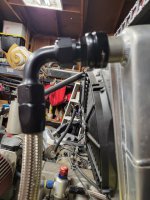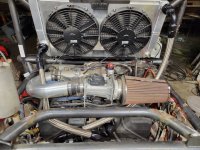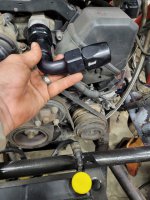You are using an out of date browser. It may not display this or other websites correctly.
You should upgrade or use an alternative browser.
You should upgrade or use an alternative browser.
arse_sidewards
Red Skull Member
- Joined
- May 19, 2020
- Member Number
- 71
- Messages
- 8,555
Seems like a great way to fatigue the shit out of the radiator.here are some more pics of that product.

350 TBI
New member
- Joined
- Jan 18, 2022
- Member Number
- 4711
- Messages
- 4
Good point...but what is the difference between the adapter and an actual bung being Tig welded to the radiator tank?
I can see if the AN hose was loaded up with tension......Anyway trying to give the guy some alternatives to Welding up a cast iron water pump.
Hope this helps someone out there......
I can see if the AN hose was loaded up with tension......Anyway trying to give the guy some alternatives to Welding up a cast iron water pump.
Hope this helps someone out there......

Using a AN/JIC to pipe there is going to be a restriction aka a bottleneck or narrowing a AN to slip into the water pump and weld IMHO is a much better proposition.
Did anyone check jegs, summit, speedway motors.
Did anyone check jegs, summit, speedway motors.
Snowracer
Well-known member
- Joined
- Jun 25, 2020
- Member Number
- 2176
- Messages
- 565
Using a AN/JIC to pipe there is going to be a restriction aka a bottleneck or narrowing a AN to slip into the water pump and weld IMHO is a much better proposition.
Did anyone check jegs, summit, speedway motors.
the jic/npt fitting is same size inside and does not tapper down ect. rest of the cooling system is all the same size so only the water pump inlet (where the fitting its going) is larger
arse_sidewards
Red Skull Member
- Joined
- May 19, 2020
- Member Number
- 71
- Messages
- 8,555
A couple inches. If your hose routing is real good it shouldn't matter but in the real world all bets are off.Good point...but what is the difference between the adapter and an actual bung being Tig welded to the radiator tank?
arse_sidewards
Red Skull Member
- Joined
- May 19, 2020
- Member Number
- 71
- Messages
- 8,555
Ever heard of a thermostat?Using a AN/JIC to pipe there is going to be a restriction aka a bottleneck or narrowing a AN to slip into the water pump and weld IMHO is a much better proposition.
Did anyone check jegs, summit, speedway motors.
TTMotorsports
Red Skull Member
Yeah I didn't run a thermostat on an old race truck and it wouldn't cool down because it had no restriction. so I installed a gutted thermostat plate on it and never had a problem after doing that and adding a bottleneck to the system
arse_sidewards
Red Skull Member
- Joined
- May 19, 2020
- Member Number
- 71
- Messages
- 8,555
That just makes no sense. Heat transfer DGAF how fast fluid is going. Gotta be weird shit going on with the pump and flow with no restriction.Yeah I didn't run a thermostat on an old race truck and it wouldn't cool down because it had no restriction. so I installed a gutted thermostat plate on it and never had a problem after doing that and adding a bottleneck to the system
CarterKraft
Red Skull Member
Are you sure?That just makes no sense. Heat transfer DGAF how fast fluid is going. Gotta be weird shit going on with the pump and flow with no restriction.
aczlan
Good Morning!
As I understand it, it's because things can get hot enough around the cylinders and heads that the water will boil unless you have the additional back pressure created by the thermostat or restrictor plate to increase the pressure on the output side of the pump by restricting flow.That just makes no sense. Heat transfer DGAF how fast fluid is going. Gotta be weird shit going on with the pump and flow with no restriction.
Aaron Z
arse_sidewards
Red Skull Member
- Joined
- May 19, 2020
- Member Number
- 71
- Messages
- 8,555
The various engines that have reverse flow cooling don't seem to have much problem with it.As I understand it, it's because things can get hot enough around the cylinders and heads that the water will boil unless you have the additional back pressure created by the thermostat or restrictor plate to increase the pressure on the output side of the pump by restricting flow.
Aaron Z

Etyler2
Your kind of Asshole
I
I don't think I would be scared of a brazed on fitting
You would if 90% here performed the work for you…
Idiots will argue but I agree.Yeah I didn't run a thermostat on an old race truck and it wouldn't cool down because it had no restriction. so I installed a gutted thermostat plate on it and never had a problem after doing that and adding a bottleneck to the system
I have had to put restrictors in multiple engines that the owners requested “no thermostat” for better cooling. GM and Ford varieties.
You can walk a mile on red hot coals barefoot without burning your feet but if you slow down or stop all of the heat gets transferred to you and burns.
arse_sidewards
Red Skull Member
- Joined
- May 19, 2020
- Member Number
- 71
- Messages
- 8,555
Try walking in circles and let us know how that goes.You can walk a mile on red hot coals barefoot without burning your feet but if you slow down or stop all of the heat gets transferred to you and burns.

CarterKraft
Red Skull Member
Do you guys want to see something not really related but kinda cool?
195° thermostat, standard waterpump '89 chevy 350.
Full flow through a 15' 1¼ hose
Dead head
The set up testing flow.
What is the take away here, I need some context...
Cooling systems under pressure are pretty important I think. Two things, raised the boiling point of the coolant and helps prevent cavitation erosion.
Water pumps can/do wear out from erosion of the volume housing.
The truck was overheating after I installed the new long block, we were trying to make sure that something wasn't plugged and we were getting good flow, and I didn't install the wrong water pump.What is the take away here, I need some context...
Cooling systems under pressure are pretty important I think. Two things, raised the boiling point of the coolant and helps prevent cavitation erosion.
Water pumps can/do wear out from erosion of the volume housing.


 I had the timing a little retarded
I had the timing a little retarded 


My understanding is that the radiator relif pressure determines the system pressure, 70s 80s 90s chevy trucks have 16psi caps; while our '58 ford has a 6 psi cap.
The thermostat or restrictor keeps water in the radiator longer so it can be cooled.
A engine that is "running cooler" is going to wear cylinders faster because of colder spots near the water jackets I assume...
I'm not afraid of engines running around 215°- 230°, our bbc tbi engines often do while pulling trailers.
arse_sidewards
Red Skull Member
- Joined
- May 19, 2020
- Member Number
- 71
- Messages
- 8,555
Pressure is not constant throughout the whole system. You'll still have a pressure differential across the pump. It'll just be relative to system pressure rather than atmosphere.My understanding is that the radiator relif pressure determines the system pressure, 70s 80s 90s chevy trucks have 16psi caps; while our '58 ford has a 6 psi cap.
Your cylinder head sealing situation is usually the limiting factor in theory since you can't put a lot of force on that connection (because whatever holds the combustion pressure is where the bulk of the force gets applied) so you just have to rely on a few thou of gasket crush and cross your fingers. In practice the rest of the cooling system is designed around whatever this pressure is so you'll start popping other random shit if you go above that pressure.
and keeps the water in the head longer so it can be heated more...The thermostat or restrictor keeps water in the radiator longer so it can be cooled.
Too cold, yes. But 160+ should be fine in the overwhelming majority of engines. I agree there's nothing to be afraid of north of 200 as long as you're comfortably below boiling tempA engine that is "running cooler" is going to wear cylinders faster because of colder spots near the water jackets I assume...
I'm not afraid of engines running around 215°- 230°, our bbc tbi engines often do while pulling trailers.


